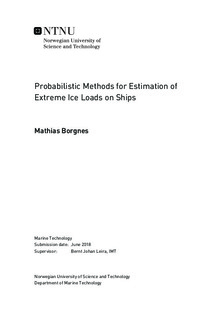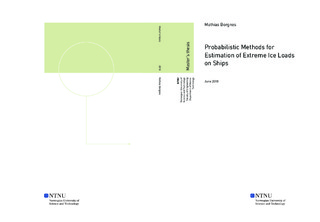| dc.description.abstract | The maritime activity in the Arctic Ocean is ever increasing, as the reduced ice extent reveals new resources and new shipping routes. Ice loading processes due to ship-ice interaction are highly complex and yet not fully understood. Many probabilistic methods for describing the ice loading process and its extreme values are proposed in the literature. However, all of them seem to have flaws or weaknesses, thus no universal method is verified. The purpose of this thesis is to compare different methods for estimation of short-term extreme loads, with a focus on revealing their strengths and weaknesses. Full-scale measurements from KV Svalbard are used for analyses. The applied probabilistic methods are; the classical approach, the asymptotic approach, application of a three-parameter exponential distribution, and the average conditional exceedance rate (ACER) method.
A review of sea ice and ice formation is performed. Mechanical and physical properties of ice are described, i.e., strength, ductility, fracture toughness and Young's modulus. The most critical parameters for the properties were found to be porosity, strain rate, temperature and macrostructure. Moreover, the ice-breaking process is described with associated pressures and loads.
Many of the applied methods are based upon the assumption of stationarity. However, since the ice loading process is highly complex, it is not straightforward which conditions and characteristics that must be stationary to provide stationarity for the measured ice load peaks. Previous works on the same subject present different requirements when stationarity is strived for. Therefore, a brief study on how ice thickness and vessel speed affect the estimated extreme ice load is carried out. The study provides strong indications that the ice thickness has a significant impact on the estimated extreme load, whereas no correlation was found for the vessel speed.
The applied probabilistic methods for estimating extreme loads are described and implemented in MATLAB. Several time series for analyses were identified based on the study related to stationarity. Different categories of load patterns were observed for the data sets. Four of the data sets were selected for comparison of the methods, where the most frequently observed load patterns were represented; one set containing an outlier, one set where two load populations were identified, one set with scattered loads in the upper tail, and a set that exhibited a highly stationary load pattern.
Most of the applied methods provide good fits and estimates of extreme loads if the data sets are selected with some care. Thus, the selection of method should depend on what kind of data that is being analyzed, and what the purpose of the application is. The exponential and Weibull distributions provide good fits to data collected during stationary ice conditions. However, stationary ice conditions are rarely encountered in Arctic waters, which makes these methods unsuitable for live estimation of extreme loads. The three-parameter exponential distribution is more flexible than the regular exponential distribution, by means of the ability to capture a more extensive variety of load patterns. The ACER method provides inconsistent results when applied to time series of short duration (less than 30 min), which made it difficult to compare with the other methods. The asymptotic approach using type I extreme value distribution, i.e., the Gumbel, was found to be the most robust method, in the sense of providing satisfactory fits and estimates of extreme loads for a wide range of load patterns. It was also found to be better than the ACER method for 6 hours non-stationary time series. However, none of the methods were able to capture outliers, which were found for several data sets. It is questionable whether the outliers are actual loads or measuring errors. This should be investigated to be able to develop accurate models for extreme load estimation. | |

